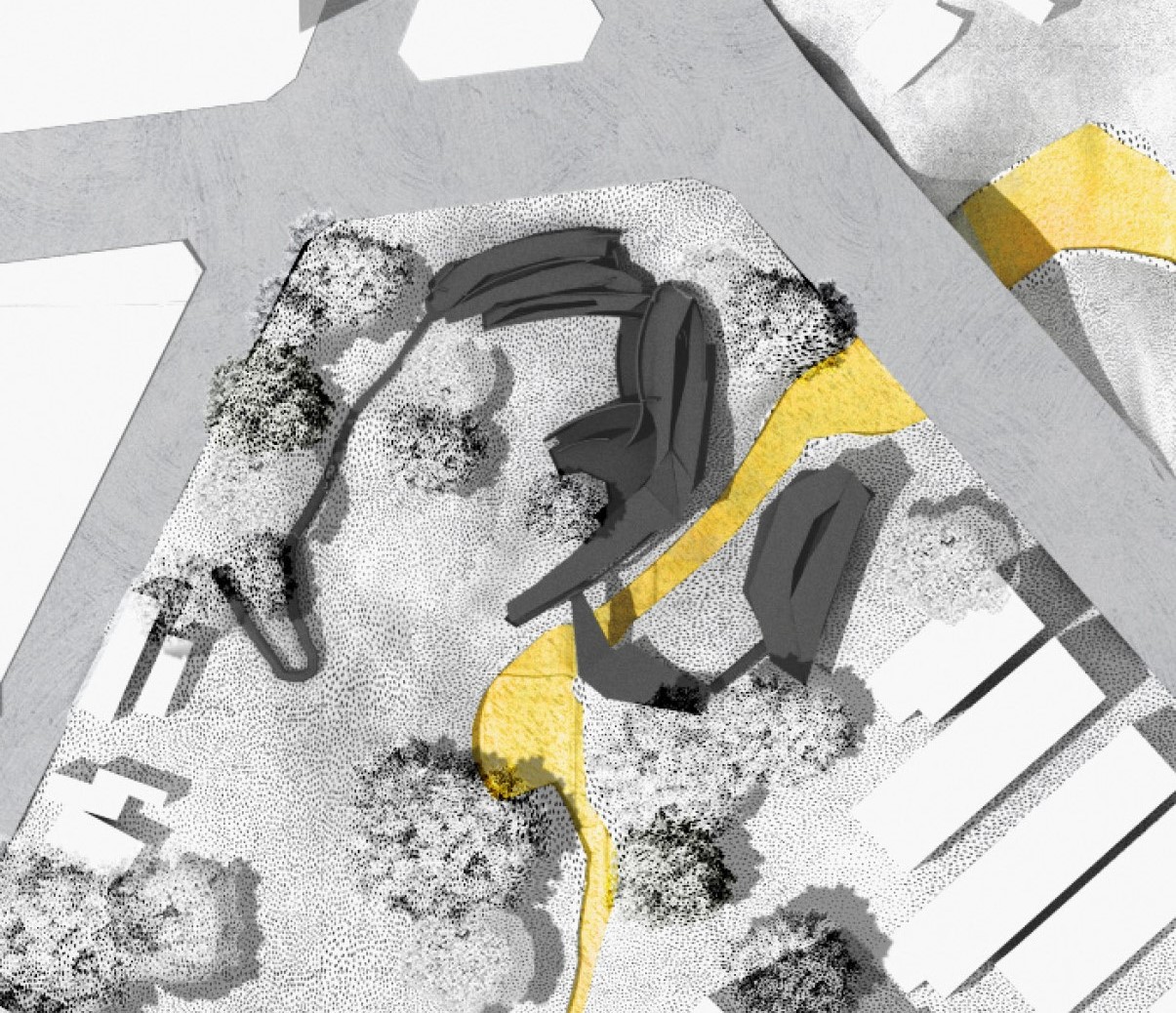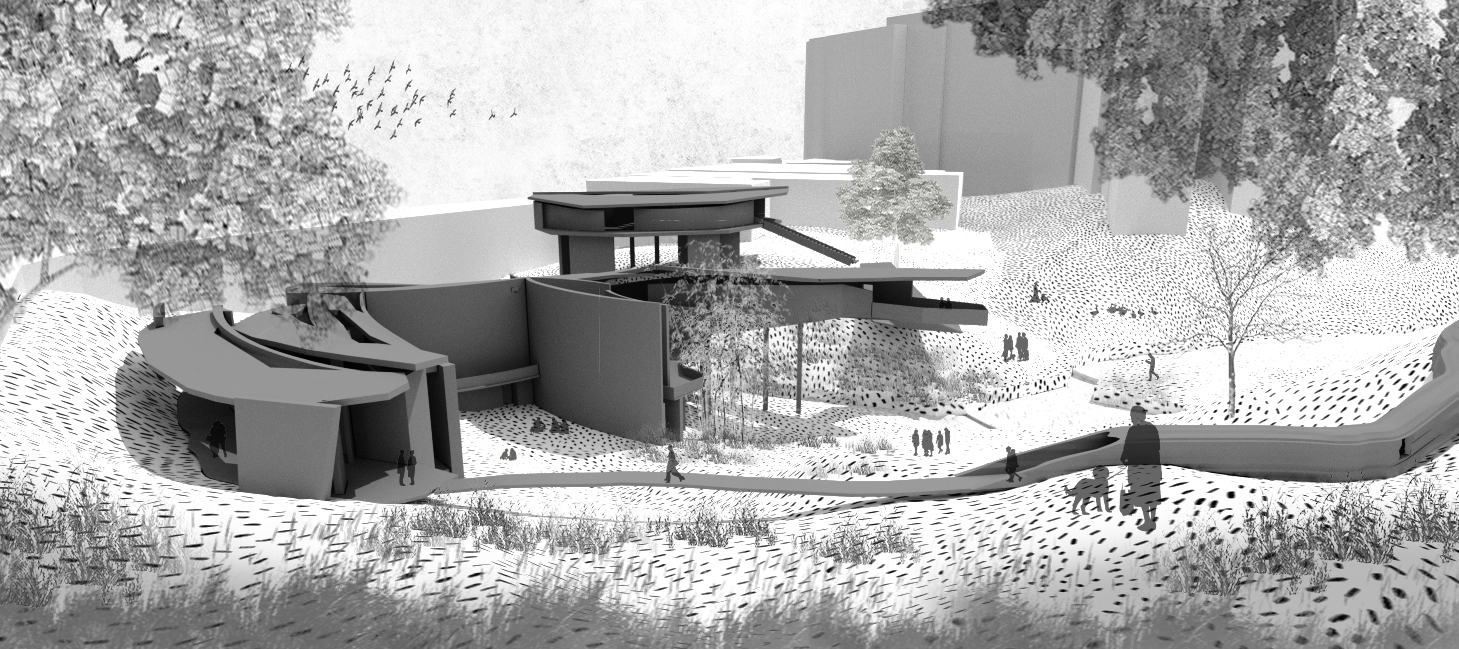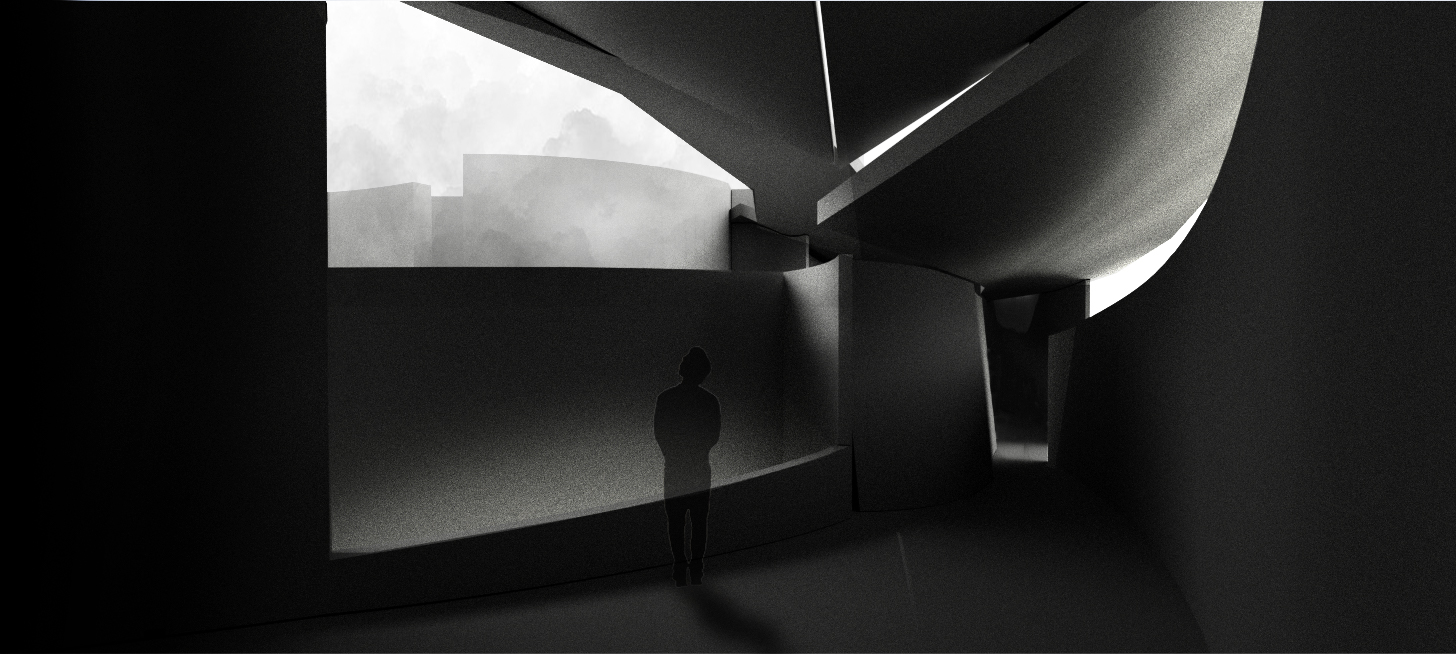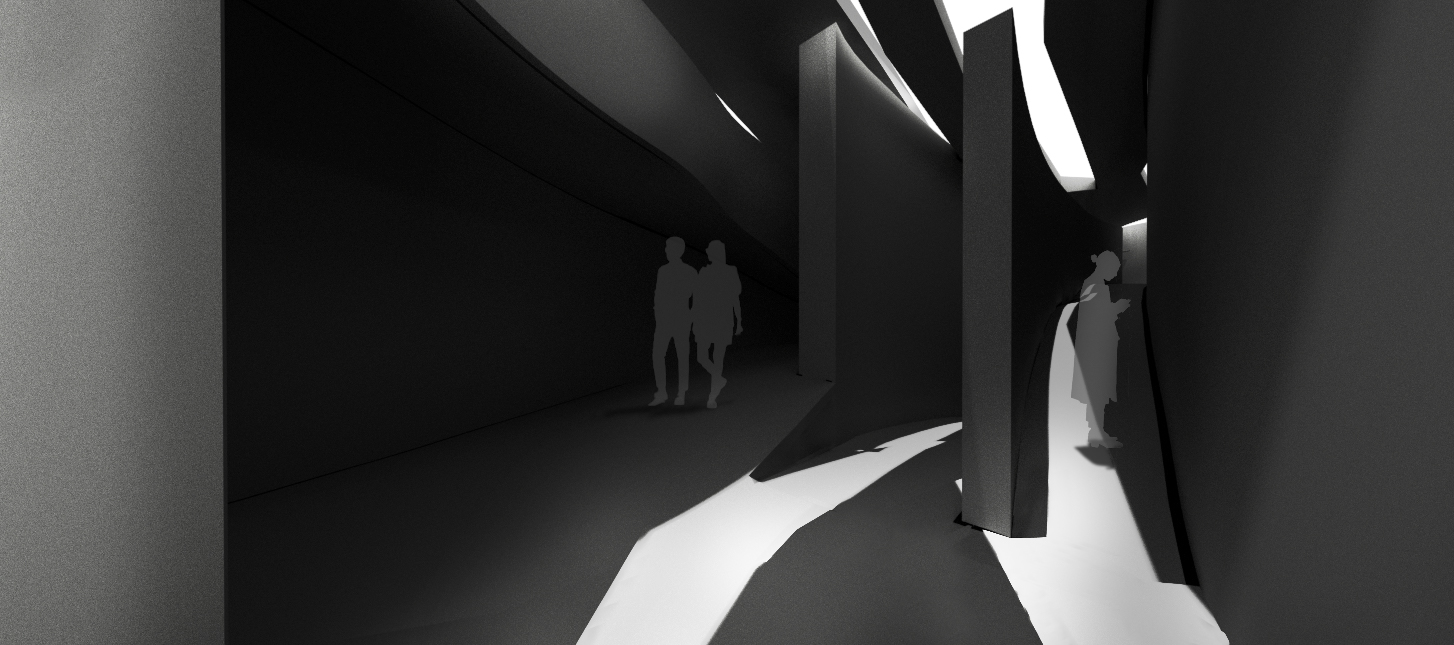Whispering a Tainistory
a cemetry and museum of Tainan
1.
background
interface - urban and cemetery, life and dead
Different countries have different customs for worshiping their ancestors. Consequently, as a symbolization, cemeteries and religious places are essential to a city and its dwellers. In contrast to where human activities generally occur, the in-between zones carry a significant meaning and spiritual impact. Therefore, how does the design respond to the inevitable interface when the urban meets the graveyard?
The site, Shuijiaoshe, has been a cemetery since the Qing dynasty(1980) and is where the margin of Tainan castle lies. As people move closer to the castle wall from the town, the verdant landscape with an increasingly thrilling atmosphere tells visitors of their arrival at a sacred cemetery space. The process of experiencing in-between ribbons is unconscious, gradual, and harmonious, which seems to spiritually proliferate passersby’s emotions toward worshiping.
However, boosting populations and ongoing urban development, like the expanding construction of residential or commercial buildings, influence the middle spaces between regions of urban activities and areas for commemorating ancestors and even force some families to transfer family members buried in the past to a better place. As the buffering area swallowed and turned into a transparent surface, a casual tour of visiting a spiritual place became an abrupt transition, both physically and mentally.
2.
intention
interference - a park for Tainan, stories for denizens
Converting the concept of a current invasion phenomenon in which towns overlap cemeteries, the project attempts to interfere with a memorial park where people can have internal communication and ancestral worship. The park dissolves an unseen wall boundary at the intersection that blurs the paradox of meeting a sacred and thrilling place by only crossing a street. At the exact moment, the park is also a reminder of Shuijiaoshe history and Tainan history, so it comes to be a museum, storing and exhibiting.
3.
method/process
collecting the sound, collecting the mind
When the sense of sight is compromised by dim lighting, sounds feel more amplified, scents more distinct, and physical contact more electrifying. Interestingly, to reduce nervousness at a place adjacent to the tombs, closing our eyes makes the sights turn into blank paper, which allows memories and imagination to project; as a result, The cemetery becomes less terrifying, and hearts are allowed to calm down and collect itself.
The park, a wasteland, is also viewed as a junction on the interface between the city and cemetery. There are kinds of voices mingling together but are respectively expressed at some specific places from time to time when listeners walk around. Frequency and quantity are changeable elements representing the sequence of time and space.
The project's initiation is to analyze the noise visitors can hear at the site and collect them through space design. For instance, sounds of passing vehicles, the rustling of bamboo leaves, and the murmur of a river – all are presented in the walking flow, the formation affecting the inner atmosphere, and subsequently, the exterior shapes interacting with the surroundings.
4.
result
a trace of finding inner stories, understanding the Tainan history-a cemetry and a museum
Sound tracing is a process that draws several indexes at the spot where reference lines indicate the walking routes and intersection points that reveal the gathering platforms. The architecture eventually follows the terrain, declining from the outer ring to the inner, overlooking a grassland encircled by the masses and nature.
Through the interpretation sequence for the spots subjectively seen and the sound objectively heard. The formation of spaces visualizes every personal concept of the experience. Therefore, the park has three phases of intentions: composing, attending, and collecting.
The first phase is an experiment that derives from the first variation of sight and voice when entering the place. The experimentation is to design a tunnel whose incoming light and sound insulation changes are in progress, inviting visitors to feel the difference in a short linear aisle.
Second, the central part of the park is Tainan city’s columbaria, a building designed to house cremation urns of ancestors. A continuous ramp gradually descends, also generating a curved flow system. Visitors simultaneously escape from the noise made by passing vehicles and subsequently embrace the sound, which informs a relationship between wind and Chinese bamboo. Along the ramp, sound and volume are constantly changing, with three areas of the wall niches appearing in sequence. Oppositely, wall niches incline or are gathered in one area. The sunroof invites the light to the aisles for worship.
Near the stream, the murmuring of the river is contained in a semi-outdoor bridge with a cave-like shelter. Repetitive echo accompanies the exhibition which introduces the history of Tainan. Flowing water is like a paradox, contrasting the historical records.
The last part of the park is an expansion of the living place in the neighborhood. Crossing the river, a short-term living house, apart from other areas, is a kidney-shaped island. Due to the isolation from disturbing sounds, the house allows recollections, reflections, and listening to one’s mind.
background
interface - urban and cemetery, life and dead
Different countries have different customs for worshiping their ancestors. Consequently, as a symbolization, cemeteries and religious places are essential to a city and its dwellers. In contrast to where human activities generally occur, the in-between zones carry a significant meaning and spiritual impact. Therefore, how does the design respond to the inevitable interface when the urban meets the graveyard?
The site, Shuijiaoshe, has been a cemetery since the Qing dynasty(1980) and is where the margin of Tainan castle lies. As people move closer to the castle wall from the town, the verdant landscape with an increasingly thrilling atmosphere tells visitors of their arrival at a sacred cemetery space. The process of experiencing in-between ribbons is unconscious, gradual, and harmonious, which seems to spiritually proliferate passersby’s emotions toward worshiping.
However, boosting populations and ongoing urban development, like the expanding construction of residential or commercial buildings, influence the middle spaces between regions of urban activities and areas for commemorating ancestors and even force some families to transfer family members buried in the past to a better place. As the buffering area swallowed and turned into a transparent surface, a casual tour of visiting a spiritual place became an abrupt transition, both physically and mentally.
2.
intention
interference - a park for Tainan, stories for denizens
Converting the concept of a current invasion phenomenon in which towns overlap cemeteries, the project attempts to interfere with a memorial park where people can have internal communication and ancestral worship. The park dissolves an unseen wall boundary at the intersection that blurs the paradox of meeting a sacred and thrilling place by only crossing a street. At the exact moment, the park is also a reminder of Shuijiaoshe history and Tainan history, so it comes to be a museum, storing and exhibiting.
3.
method/process
collecting the sound, collecting the mind
When the sense of sight is compromised by dim lighting, sounds feel more amplified, scents more distinct, and physical contact more electrifying. Interestingly, to reduce nervousness at a place adjacent to the tombs, closing our eyes makes the sights turn into blank paper, which allows memories and imagination to project; as a result, The cemetery becomes less terrifying, and hearts are allowed to calm down and collect itself.
The park, a wasteland, is also viewed as a junction on the interface between the city and cemetery. There are kinds of voices mingling together but are respectively expressed at some specific places from time to time when listeners walk around. Frequency and quantity are changeable elements representing the sequence of time and space.
The project's initiation is to analyze the noise visitors can hear at the site and collect them through space design. For instance, sounds of passing vehicles, the rustling of bamboo leaves, and the murmur of a river – all are presented in the walking flow, the formation affecting the inner atmosphere, and subsequently, the exterior shapes interacting with the surroundings.
4.
result
a trace of finding inner stories, understanding the Tainan history-a cemetry and a museum
Sound tracing is a process that draws several indexes at the spot where reference lines indicate the walking routes and intersection points that reveal the gathering platforms. The architecture eventually follows the terrain, declining from the outer ring to the inner, overlooking a grassland encircled by the masses and nature.
Through the interpretation sequence for the spots subjectively seen and the sound objectively heard. The formation of spaces visualizes every personal concept of the experience. Therefore, the park has three phases of intentions: composing, attending, and collecting.
The first phase is an experiment that derives from the first variation of sight and voice when entering the place. The experimentation is to design a tunnel whose incoming light and sound insulation changes are in progress, inviting visitors to feel the difference in a short linear aisle.
Second, the central part of the park is Tainan city’s columbaria, a building designed to house cremation urns of ancestors. A continuous ramp gradually descends, also generating a curved flow system. Visitors simultaneously escape from the noise made by passing vehicles and subsequently embrace the sound, which informs a relationship between wind and Chinese bamboo. Along the ramp, sound and volume are constantly changing, with three areas of the wall niches appearing in sequence. Oppositely, wall niches incline or are gathered in one area. The sunroof invites the light to the aisles for worship.
Near the stream, the murmuring of the river is contained in a semi-outdoor bridge with a cave-like shelter. Repetitive echo accompanies the exhibition which introduces the history of Tainan. Flowing water is like a paradox, contrasting the historical records.
The last part of the park is an expansion of the living place in the neighborhood. Crossing the river, a short-term living house, apart from other areas, is a kidney-shaped island. Due to the isolation from disturbing sounds, the house allows recollections, reflections, and listening to one’s mind.
diagram drawings






plans


sections

visualizations




models

